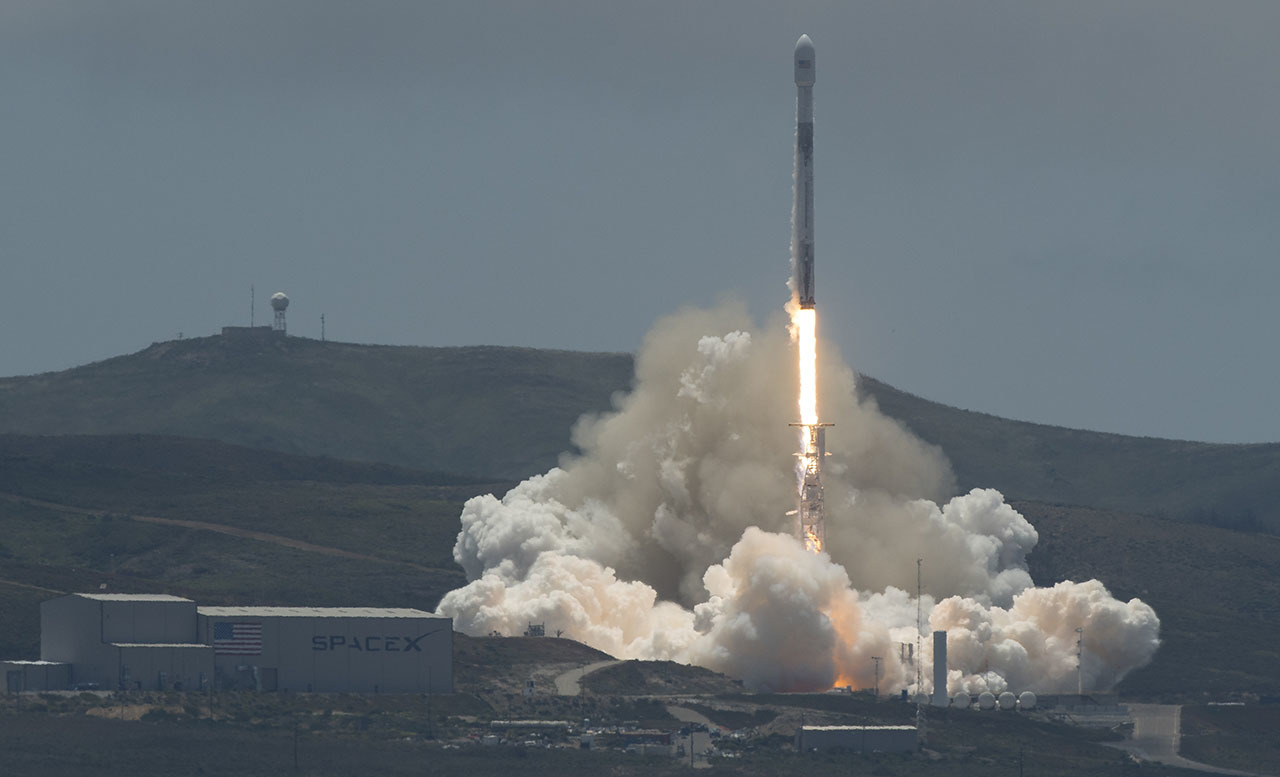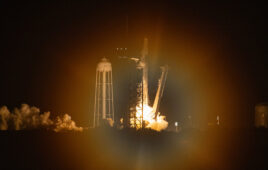
The NASA/German Research Centre for Geosciences GRACE Follow-On spacecraft launch onboard a SpaceX Falcon 9 rocket, Tuesday, May 22, 2018, from Space Launch Complex 4E at Vandenberg Air Force Base in California. The mission will measure changes in how mass is redistributed within and among Earth’s atmosphere, oceans, land and ice sheets, as well as within Earth itself. GRACE-FO is sharing its ride to orbit with five Iridium NEXT communications satellites as part of a commercial rideshare agreement. Credit: NASA/Bill Ingalls
SpaceX has successfully launched Iridium-6/GRACE-FO, a Falcon 9 rocket carrying satellites for two different missions—one that will monitor Earth’s water movement, and another that will serve as an upgrade to the world’s largest commercial communication satellite network.
The Elon Musk-led company launched five Iridium-6 satellites and two GRACE-FO satellites on May 22 from the Space Launch Complex 4E at Vandenberg Air Force Base in California at 12:47 Pacific Daylight Time.
According to SpaceX, the GRACE-FO satellites were deployed about 11 minutes and 30 seconds following the launch, while the five Iridium NEXT satellites were deployed about an hour following the launch.
Falcon 9’s first stage for the Iridium-6/GRACE-FO mission previously supported the Zuma mission from Space Launch Complex 40 (SLC-40) at Cape Canaveral Air Force Station in January. SpaceX did not attempt to recover Falcon 9’s first stage following the launch.
The launch of Iridium-6 represents the sixth of eight-planned Iridium NEXT missions as part of a campaign to replace the world’s largest commercial satellite network. Iridium represents the world’s only satellite communications network that spans the entire globe.
Overall, the eight Iridium missions are expected to deliver 75 new satellites into orbit. There are 81 satellites in total being built, 66 in the operation constellation, nine serving as on-orbit spaces and six as ground spares.
The process of replacing satellites one by one in a constellation of this size and scale has never previously been completed. The new constellation is expected to enable the development of innovative products and services that include Iridium Certus—SpaceX’s next-generation broadband solution for specialized applications including safety services, data and communications, remote monitoring and tracking.
Sharing the ride to space with the Iridium NEXT communications satellites was the GRACE-FO (GRACE Follow-On) mission. This is a joint effort between NASA and the German Research Centre for Geosciences (GFZ) to track the continuous movement of water and other changes in Earth’s mass on and beneath the planet’s surface. It is part of a 15-year history for GRACE in tracking the movement of the Earth’s mass. The mission has provided monthly maps of regional gravity variations since it was first launched, providing new insights into how the Earth system functions and responds to change.
As the twin satellites fly over areas of higher and lower mass, the distance between them changes slightly because of gravitational forces. Precise measurements of the changes enables researchers to monitor changes in ice sheets and glaciers, underground water storage, water in large lakes and rivers and sea levels, providing a unique view of Earth’s evolving climate and its water and energy cycles.
“GRACE-FO will provide unique insights into how our complex planet operates,” said Thomas Zurbuchen, associate administrator of NASA’s Science Mission Directorate at NASA Headquarters in Washington in a statement. “Just as important, because the mission monitors many key aspects of the Earth’s water cycle, GRACE-FO data will be used throughout the world to improve people’s lives — from better predictions of drought impacts to higher-quality information on use and management of water from underground aquifers.”
The GRACE-FO satellites will spend their first few days in space moving to the separation distance needed to perform their mission. When they reach this distance, the mission will begin an 85-day, in-orbit checkout phase. Mission managers will evaluate the instruments and satellite systems and perform calibration and alignment procedures. Then the satellites will begin gathering and processing science data. The first science data are expected to be released in about seven months.
Over its five-year mission, GRACE-FO will monitor the movement of mass around our planet by measuring where and how the moving mass changes Earth’s gravitational pull.




